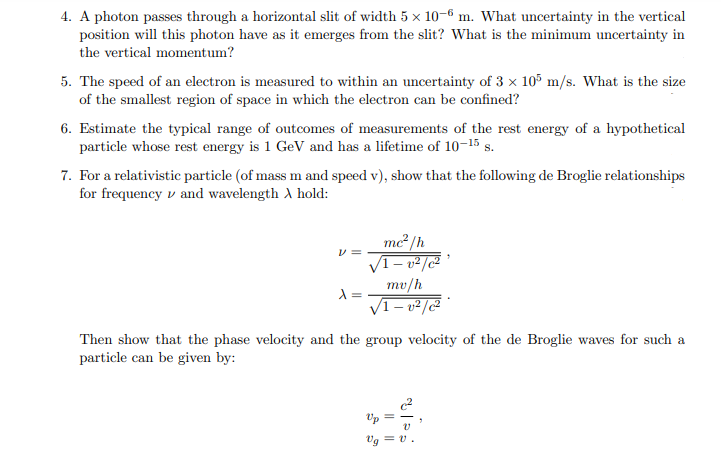4. A photon passes through a horizontal slit of width 5 x 10-6 m. What uncertainty in the vertical position will this photon have as it emerges from the slit? What is the minimum uncertainty in the vertical momentum?
4. A photon passes through a horizontal slit of width 5 x 10-6 m. What uncertainty in the vertical position will this photon have as it emerges from the slit? What is the minimum uncertainty in the vertical momentum?
Principles of Physics: A Calculus-Based Text
5th Edition
ISBN:9781133104261
Author:Raymond A. Serway, John W. Jewett
Publisher:Raymond A. Serway, John W. Jewett
Chapter28: Quantum Physics
Section: Chapter Questions
Problem 20CQ
Related questions
Concept explainers
Question

Transcribed Image Text:4. A photon passes through a horizontal slit of width 5 x 10-6 m. What uncertainty in the vertical
position will this photon have as it emerges from the slit? What is the minimum uncertainty in
the vertical momentum?
5. The speed of an electron is measured to within an uncertainty of 3 x 105 m/s. What is the size
of the smallest region of space in which the electron can be confined?
6. Estimate the typical range of outcomes of measurements of the rest energy of a hypothetical
particle whose rest energy is 1 GeV and has a lifetime of 10-15 s.
7. For a relativistic particle (of mass m and speed v), show that the following de Broglie relationships
for frequency and wavelength A hold:
V =
X
me²/h
√1-v²/c²'
mv/h
√1-v²/c²
Then show that the phase velocity and the group velocity of the de Broglie waves for such a
particle can be given by:
Vg = v.
Expert Solution
This question has been solved!
Explore an expertly crafted, step-by-step solution for a thorough understanding of key concepts.
Step by step
Solved in 2 steps with 2 images

Knowledge Booster
Learn more about
Need a deep-dive on the concept behind this application? Look no further. Learn more about this topic, physics and related others by exploring similar questions and additional content below.Recommended textbooks for you

Principles of Physics: A Calculus-Based Text
Physics
ISBN:
9781133104261
Author:
Raymond A. Serway, John W. Jewett
Publisher:
Cengage Learning

Physics for Scientists and Engineers with Modern …
Physics
ISBN:
9781337553292
Author:
Raymond A. Serway, John W. Jewett
Publisher:
Cengage Learning

College Physics
Physics
ISBN:
9781285737027
Author:
Raymond A. Serway, Chris Vuille
Publisher:
Cengage Learning

Principles of Physics: A Calculus-Based Text
Physics
ISBN:
9781133104261
Author:
Raymond A. Serway, John W. Jewett
Publisher:
Cengage Learning

Physics for Scientists and Engineers with Modern …
Physics
ISBN:
9781337553292
Author:
Raymond A. Serway, John W. Jewett
Publisher:
Cengage Learning

College Physics
Physics
ISBN:
9781285737027
Author:
Raymond A. Serway, Chris Vuille
Publisher:
Cengage Learning

Modern Physics
Physics
ISBN:
9781111794378
Author:
Raymond A. Serway, Clement J. Moses, Curt A. Moyer
Publisher:
Cengage Learning

College Physics
Physics
ISBN:
9781938168000
Author:
Paul Peter Urone, Roger Hinrichs
Publisher:
OpenStax College

University Physics Volume 3
Physics
ISBN:
9781938168185
Author:
William Moebs, Jeff Sanny
Publisher:
OpenStax